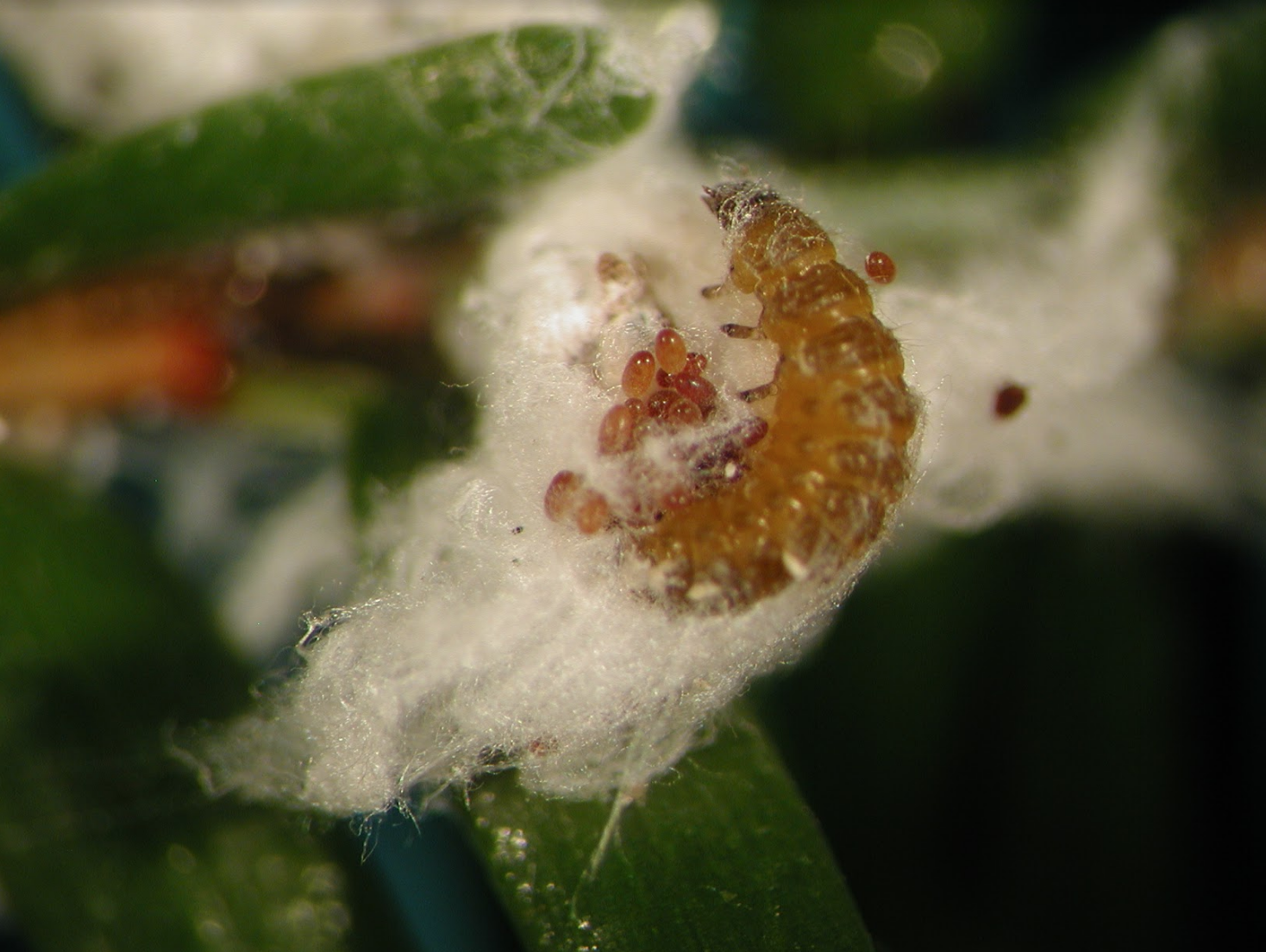Laricobius nigrinus on:
[Wikipedia]
[Google]
[Amazon]
 ''Laricobius nigrinus'' is a species of tooth-necked fungus beetle in the family
''Laricobius nigrinus'' is a species of tooth-necked fungus beetle in the family
File:L nigrinus adult feeding.png, Adul''t L. nigrinus'' feeding on ''A. tsugae''
 ''Laricobius nigrinus'' is a species of tooth-necked fungus beetle in the family
''Laricobius nigrinus'' is a species of tooth-necked fungus beetle in the family Derodontidae
Derodontidae is a family of beetles, in its own superfamily, Derodontoidea, sometimes known as the tooth-necked fungus beetles. Beetles of this family are small, between 2 and 6 mm in length, typically with spiny margins on their pronotum (p ...
. It is native to western North America, and it is being studied as a biological control
Biological control or biocontrol is a method of controlling pests, such as insects, mites, weeds, and plant diseases, using other organisms. It relies on predation, parasitism, herbivory, or other natural mechanisms, but typically also invo ...
agent for the hemlock woolly adelgid
The hemlock woolly adelgid (; ''Adelges tsugae''), or HWA, is an insect of the order Hemiptera (true bugs) native to East Asia. It feeds by sucking sap from hemlock and spruce trees (''Tsuga'' spp.; ''Picea'' spp.). In its native range, HWA ...
. It was first released in 2003 and continues to be reared and released across the Northeast to control infestations.
Taxonomy
''Laricobius nigrinus'' was first described by Kenneth Fender in 1945 from specimens collected in Oregon. ''Laricobius'' is one of four genera in Derodontidae. The genus has a Holarctic distribution, with most species native to Asia.Description
Adult beetles have a black body, clubbed antennae with eleven segments, and two ocelli. Their palps, antennae, and tarsi are dark brown to red. The head is partially visible from above. They are usually 2.3-2.9 mm long, with no significant sex differences in size. The species can be distinguished from other black ''Laricobius'' by its toothed pronotal margin. Its eggs are yellow and oblong, usually laid in the ovisacs of ''A. tsugae''. The larvae have three segmented antennae, a well-developed head with twelve stemmata and hairy abdominal segments. They are "oligopod type" larvae, with three pairs of thoracic legs, and no prolegs. The larvae start as yellow before darkening to yellow green/yellow brown with maturity. Pupae resemble the adult form, and individuals can be sexed in pupal form.Habitat, life cycle and behavior
All members of ''Laricobius'' feed on members ofAdelgidae
The Adelgidae are a small family of the Hemiptera closely related to the aphids, and often included in the Aphidoidea with the Phylloxeridae or placed within the superfamily Phylloxeroidea as a sister of the Aphidoidea within the infraorder Aph ...
, and ''Laricobius nigrinus'' is specialized on the hemlock woolly adelgid. The predatory life history of ''Laricobius'' is unique among the family as most derodontids are fungal feeders. ''L. nigrinus'' is native to hemlock forests in the Pacific Northwest. It can be found throughout the western U.S. and Canada, and specimens in the U.S. Museum of Natural History have been collected as far north as the southeastern Yukon. It has a univoltine
Voltinism is a term used in biology to indicate the number of broods or generations of an organism in a year. The term is most often applied to insects, and is particularly in use in sericulture, where silkworm varieties vary in their voltinism.
...
life cycle, completing one generation per year. Eggs are laid in early spring, and its development is synchronized with the winter/spring generation of ''A. tsugae''.Mausel, D. L., Davis, G. A., Lamb, A. S., Zilahi-Balogh, G. M. G., Kok, L. T., & Salom, S. M. (2011). Laricobius nigrinus Fender (Coleoptera: Derodontidae). ''ImplementatIon and StatuS of BIologIcal control of the hemlock Woolly adelgId'', 77. Females lay an average of 100 eggs during their lifetimes. ''L. nigrinus'' goes through four larval instars, and the larvae use secretions to glue debris and adelgid wool to themselves as camouflage. Fourth instar larvae drop to the ground as prepupae and complete their development in the soil before emerging as adults in the fall. Similar to its prey, ''L. nigrinu''s is dormant during the summer months, aestivating as a pupa. The adult beetles feed on adult adelgids, while the larvae feed on the eggs of the spring progrediens generation. They have a temperature dependent development, and cannot complete development above 21 °C. They are significantly more active during the day than at night. Their flight behavior is responsive to prey densities, and they will only fly when their food source is scarce. They use scent to home in on adelgids at close range, and respond to the odors of the adelgid's native host tree, western hemlock as well as the odors of western white pine and white spruce.
Biological control
Due to its narrow prey specificity and geographic range, ''L. nigrinus'' was approved by USDA-APHIS for release as a biological control agent in 2000. Field releases began in 2003, and populations have expanded to cover a wide range of ''A. tsugae'' infestation. As of 2021 it has been released in 18 states, and has established in Pennsylvania, Maryland, New York, New Jersey, Virginia, Georgia, West Virginia, North Carolina, Tennessee, Connecticut, Massachusetts, Maine, and New Hampshire. Releases are continuing throughout the infestation range. It has been shown to strongly impact ''A. tsugae'' densities in experiments conducted in their native range, and a recent study found that ''L. nigrinus'' has a significant impact on the mortality of ''A. tsugae'' eggs at caged release sites. Studies are ongoing to determine the rate of hybridization between ''L. nigrinus'' and its native congener, '' Laricobius rubidus'' which feeds on pine bark adelgid.References
Further reading
* {{Taxonbar, from=Q2627566 Derodontidae Articles created by Qbugbot Beetles described in 1945 Insects used as insect pest control agents Beetles of North America